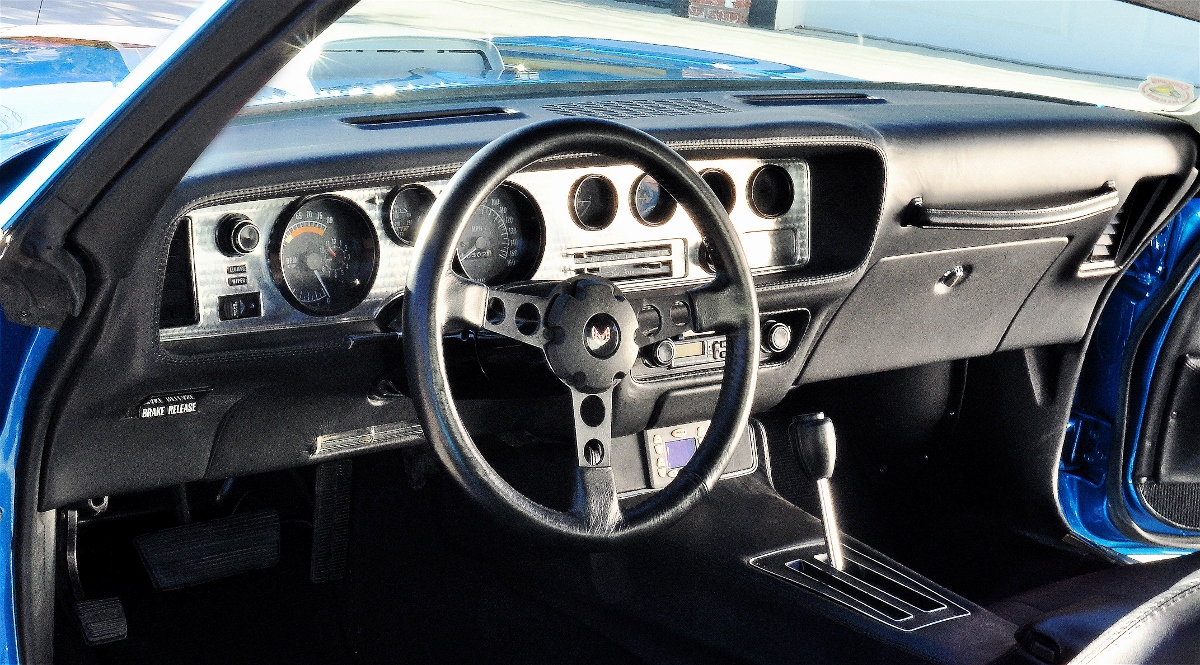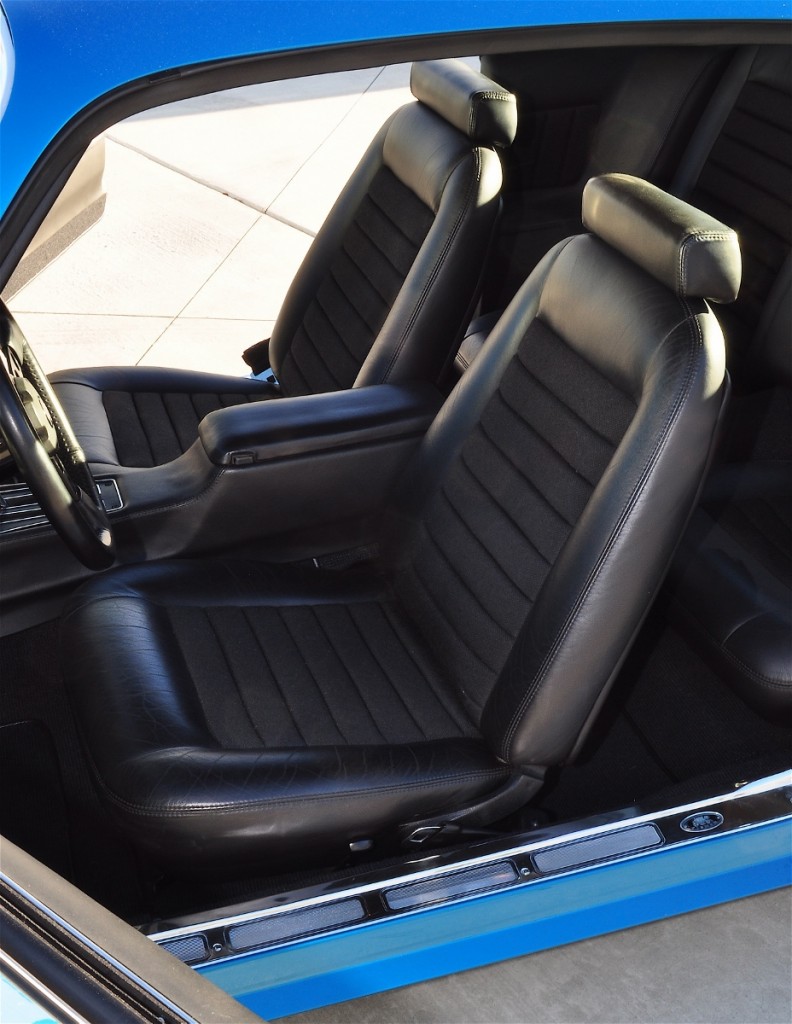A one-owner ‘70 T/A with tons of history
Words and Photos: James Maxwell
When the Pontiac Division stylists were given the job to create an all-new 2nd generation Firebird, they wanted to make sure the car would incorporate that certain “Pontiac personality” that gave the division its own unique position in the marketplace.

Clean layout of instrumentation was a European influence given to the interior. John DeLorean himself was the guiding force in getting the three-spoke, soft-rimmed 14-inch diameter Formula steering wheel into production. Ron Mangus was responsible for all the upholstery work, and today the interior appears “factory fresh,” including the original low-back buckets. Pontiac switched to high-back buckets starting in 1971.
The general vibe built around Pontiac at this time was that even though many more people may have purchased Chevrolets because they needed a car, buyers went to Pontiac dealerships because they wanted a car. Most everyone knew the Pontiac line had something special to offer; more bold and flamboyant, they attracted a more upscale buyer compared to GM sales leader Chevrolet.
The Camaro and Firebird were known as the F-Body Platforms, and General Motors’ front office often managed to cut production costs by getting the divisions to work together while developing new models. Such was the case when these second-gen cars were being designed. Pontiac managed to add a lot of spice to their version and from the very start had a design philosophy that was to give the car a European flavor.
One of their styling targets at the time was the Lamborghini Miura. In fact, Pontiac Division head John DeLorean drove at the time a Maserati Ghibi, which had a price tag in the $12,000 range — a ton of money in the late ’60s for a car! DeLorean told the studio designers to make the new Firebird “to be like a $3,000.00 Ghibi” as encouragement to make the most of the opportunity to create a brand new Pontiac pony car.
Unlike the earlier 1967-69 F-body cars, a convertible version was not offered, as sales had been tumbling for drop-top cars, largely because of the increased popularity of the air conditioning option. While the wheelbase remained at 108 inches, the new car platform had an entirely different look featuring all-new proportions. The “long hood, short deck” theme was incorporated in the basic shape and long doors, and big side glass (with no quarter windows) were part of the new shape. Key to all the changes was to give the Firebird a lowered stance all around. The end result was a body shape that was very fluid, wild, futuristic, and at the same time, simple and clean.
 Pontiac was able to make the Firebird unique from the Camaro in a number of ways. One example is the doors of the two cars do not interchange. DeLorean insisted the Firebird not just be a Camaro with a few little, minor changes to the front and rear. Included in the changes was a dashboard that differed greatly from the Camaro and hood scoops (on Formula 400 and Trans Am models); the Camaro only offered a flat hood. The Firebird also had softer lines and no sharp edges.
Pontiac was able to make the Firebird unique from the Camaro in a number of ways. One example is the doors of the two cars do not interchange. DeLorean insisted the Firebird not just be a Camaro with a few little, minor changes to the front and rear. Included in the changes was a dashboard that differed greatly from the Camaro and hood scoops (on Formula 400 and Trans Am models); the Camaro only offered a flat hood. The Firebird also had softer lines and no sharp edges.
To help provide up-level content, the studio designers were able to convince the bean counters in the front office to incorporate the Endura front bumper on all models of the Firebird. Besides looking sleek, the body-color Endura bumper with its hard-rubber-like material resisted dings and dents and provided a clean, minimally chromed front end, which was the Italian flavor DeLorean desired.
The Trans Am model had very distinct differences from the other Firebirds; when you saw one coming down the road, there clearly was no mistaking it for a base or even Esprit model. In 1970, Trans Ams came in only two color choices: Polar White with blue stripes and Lucerne Blue with white stripes. Special Projects Chief Herb Adams had a great deal to do with the way the Trans Am came together, including getting the car on the skid pad during development and being able to incorporate oversized front and rear sway bars (sized 1.25 in front, 7/8 in rear).
In 1982, Adams told author Gary Witzenburg some of the things he worked hard to get the front office to approve for the Trans Am: “I insisted on the Trans Am being very responsive and very quick in a controlled manner. In other words, when you go into a turn, you know at all times where it’s going to go; the more input you put in the more response you’re going to get. And you don’t have to worry about the [car] all of a sudden switching ends on you.” Trans Am models came standard with variable speed, progressive-rate power steering (14.5:1 on-center, 11.1:1 at full lock), and steel Rally II wheels mounted with F60-15 white lettered tires.
A 345-hp, 400c.i. Pontiac V8 L74 engine came standard on the Trans Am models, developing 430 lb-ft of torque and using 10.5:1 compression pistons and a Rochester Quadrajet four barrel. Chrome valve covers were part of the package to show it was not just a family car power plant. An optional 370-hp version called the Ram Air IV was available special order, of which records indicate only 88 were produced.
Three transmissions were available, the Turbo HydraMatic 3-speed automatic, an M20 wide-ratio 4-speed manual, plus an M21 4-speed manual with close-ratio gearing, the two manuals equipped with a Hurst shifter. Regardless the transmission choice, 12-bolt differentials with a beefy 8.875-in ring gear was used. With the 400c.i. engine up front, the Trans Am had a 57/43 front-to-rear weight bias, and curb weight was listed at 3,782 pounds.
The body appendages added to the Trans Am were two-fold: to differentiate it from lesser models and as a means to aid in both aerodynamics and performance. The full-width front spoiler provided downforce pressure on the front end to enhance stability (even at regular highway speeds, according to the advertising literature). The air extractors located on each front fender were designed to reduce air pressure under the hood, and the front and rear wheel opening “spats” (aka wheel spoilers) were to reduce air turbulence around the wheels.
The 4.5-inch tall three-piece rear spoiler was added to build up air pressure on the rear deck and help feed the engine cool air, while the rear-facing shaker hood scoop drew in air from the high-pressure area at the base of the windshield.
Inside, the Trans Am had an individualized look as well, as there was an engine-turned face panel on the gauge cluster in which the tachometer was positioned where the redline comes in at the 12 o’clock position, in true competition car tradition.
February 26, 1970, was the much heralded release date for the 1970 second Gen Firebirds, so most consider these cars “1970 1/2” models. To help hype the release of the new Firebirds, the advertising campaign proclaimed: “The beginning of tomorrow.” And history shows it was, in fact, an accurate statement. The new body shape lasted all the way until the release of the 1982 models, a record 11 model years in all for that basic 1970 body shape.
When Hot Rod magazine got ahold of a Trans Am to test, they ran it down the drag strip (4-speed with 3.90:1 gears) in 13.9 seconds at 102 mph, starting initial acceleration at 2,000 rpm and lighting up the tires just enough to keep the engine pulling without excessive tire spin. Shifting at 5,500 rpm and with a set of slicks, there would have been lots more potential.
Car & Driver magazine had high praise for the T/A: “We just can’t be calm about the Trans Am — nobody can after he drives it. It has handling and agility closer to a racing car than anything else from Detroit with the possible, and only possible, exception of a Corvette. The variable-ratio power steering is quick, and the car responds to the most minute turn of the wheel. It corners flat as a pavement roller right up to the extremely high lateral Gs, and even then it can be subtly directed by slight pressure on the wheel or on the accelerator . . . The ride is emphatic, but not harsh, and the firmness is a small price to pay for the handling.”
Southern California residents Gil and Janet Losi purchased the pictured 1970 Trans Am brand new in early 1970, and the car has been a daily driver ever since. Gil chose the automatic transmission to make it easier for his wife to operate, and the car was always well maintained and taken good care of. Sometime in the early 1970s, a set of (then-popular) Tru-Spoke wire wheels were installed, and save for a few minor fender benders, the car always remained in great shape, albeit was slightly abused once their teenaged sons got their driver’s licenses and did a bit of street racing with it…
Gil Losi is a long-time hot rodder and through the years has built numerous hot rods, street machine’s and classic rods, but the family Trans Am was always just left stock, then parked in storage for a number of years. A few years back, the idea came to him to revive the Pontiac. His thought process was to enhance the car with a few mild modifications, first and foremost to take the stock wheel flares and mold them into the body of the car (something he felt Pontiac should have done in the first place). In addition, he wanted to put a set of larger-diameter wheels on the car for a contemporary look.
A lowered stance was accomplished via four RideTech air-adjustable shocks on each corner, and the stock 400c.i. engine (which was pretty tired and worn out from all the years) was replaced with a fresh 455 Pontiac engine, running a pump-gas friendly 9.5:1 compression ratio. The goal was to create a “rolling masterpiece” he and his wife could take out and enjoy, and when the story is told to bystanders that they are the original owners of the car, it makes for a very surprised audience.
Trans Am Trivia
Two Key points behind the development of the Trans Am
The Name
In 1969, Pontiac approached the SCCA (Sports Car Club of America) to inquire on the using of the Trans Am name (which is short for “Trans-American sedan racing series). SCCA accepted the request with the stipulation that a fee of $5.00 per car royalty is awarded to the race promoter. The rest is history.
The Engine
Because the SCCA had developed a special engine formula for their Trans Am that required a size limit of 303c.i. or less for pre-1970 race cars, no production Pontiac Firebird Trans Am car was ever legal to race the series! Pontiac engineers had to come up with specially-built tunnel port race engines of that displacement to make the car eligible for racetrack action.

















